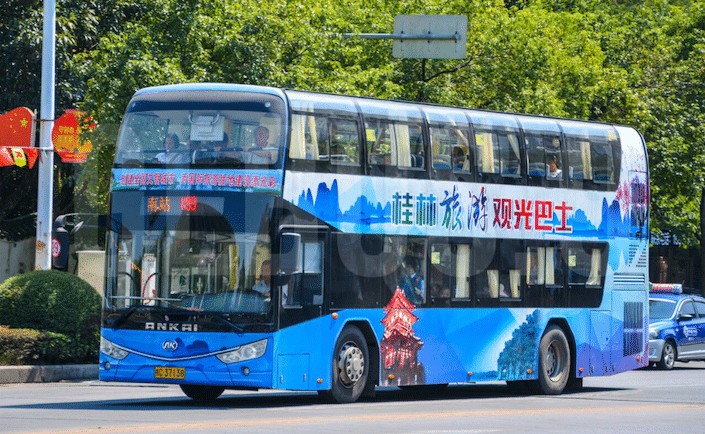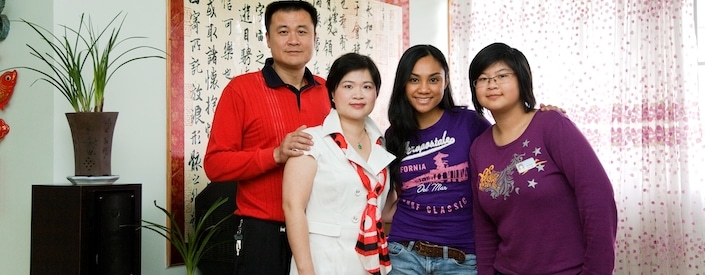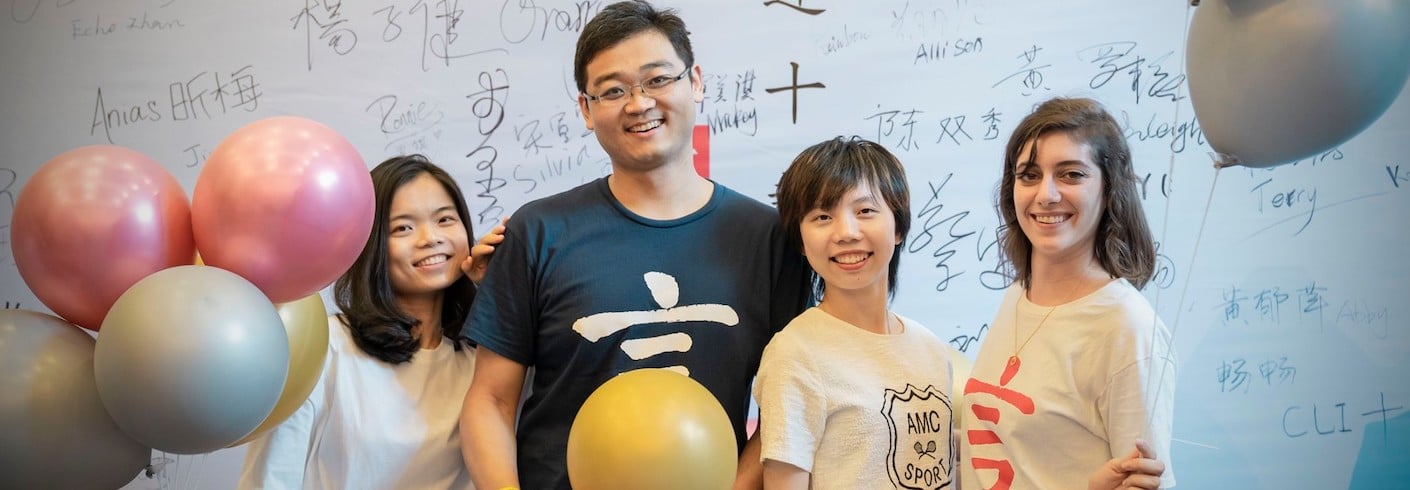
我每天坐公共汽车去学校都会看到刘师傅。刘师傅是开公共汽车的,今年50岁,大大的脸,小小的眼睛,说话的声音很大。他很喜欢帮助别人。
今天他穿着一件黑色衣服,一双白色运动鞋,戴着一块手表,拿着一个茶杯,笑着对我说:“小朋友,请上车。” 他知道我每天都在这里上车。
车到站了,他看见一位老奶奶慢慢地走上车。刘师傅觉得她生病了,就问老奶奶是不是生病了要去医院。老奶奶说:“是的,我要去医院,但是我不知道在哪儿下车。”
刘师傅说:“没关系,到站了我告诉您吧。” 公共汽车到医院那个站的时候,刘师傅帮老奶奶下了车。
虽然刘师傅的车每天因为这种事情都会晚点到学校,但是我还是很喜欢他。
是... 的 (shì...de) is a common grammatical structure in Mandarin Chinese. This pattern can be used in a variety of different ways. It is frequently used to emphasize details like the time or place at which something was done. It is also used in questions.
In this explanation, we will focus on how to use this construction to talk about what jobs people do.
To describe what someone does for a living, use the following structure:
Subject + 是 + Verb + Object + 的
In this structure, the verb and object explain the job that is done by the subject.
Let’s look at an example:
刘师傅是开公共汽车的。
Liú Shīfù shì kāi gōnggòng qìchē de.
Mr. Liu is a bus driver.
Here, Mr. Liu is the subject. After the subject comes 是 (shì; to be), followed by the verb 开 (kāi; to drive) and its object, 公共汽车 (gōnggòng qìchē; bus), followed by 的 (de). This structure is used to tell the reader that Mr. Liu drives buses for a living.
To remember how to use this construction, you can think of 是 (shì) and 的 (de) as two bookends placed on either side of detailed information about what job the person mentioned at the start of the sentence does.
Here’s another example:
我是教英语的。
Wǒ shì jiào Yīngyǔ de.
I teach English.
Like the first example above, in this sentence, the two components of the 是...的 (shì...de) structure act as bookends surrounding a description of what the subject “我” (wǒ) does for a living, namely 教英语 (jiào Yīngyǔ).
As a beginning student of Mandarin Chinese, paraphrasing is an essential skill that will allow you to begin to communicate with native speakers in your own words even if your Mandarin vocabulary is still quite limited. The 是...的 (shì...de) pattern is useful tool that can help you use paraphrasing to talk about a variety of different professions without actually knowing the formal names of each one.
For example, if you don’t know that 司机 (sījī) is the word for “driver,” you can still express the same idea by saying that a person “是开公交车的” (shì kāi gōngjiāo chē de). Likewise, if you don’t know that the more advanced word for chef is 厨师 (chúshī), you can still describe what a chef does by saying that he or she “是做饭的” (shì zuò fàn de).
The aspect particle 着 (zhe) is useful if you want to talk about an action that continues for some time instead of something that started and stopped immediately.
To use this particle, follow the pattern below:
Verb + 着
Let’s take a look at an example:
我要去商店买点东西,你帮我看着宝宝。
Wǒ yào qù shāngdiàn mǎidiǎn dōngxī, nǐ bāng wǒ kànzhe bǎobǎo.
I need to go in to buy some stuff, so you watch the baby for me.
In this example, the speaker is planning to go into a store to do some shopping, and he needs the other person to watch his baby while he does so. Since the action of watching the baby will go on for some time, 着 (zhe) is appropriate to use in this situation.
In many instances, adding 着 (zhe) after a Chinese verb is similar to adding -ing in English when describing an ongoing action such as talking, watching or singing. Thinking about 着 as similar to -ing is especially useful when you want to give some background information and show the context in which another more discrete, non-continuous action was performed.
When using 着 (zhe) to describe an ongoing state, use the following structure:
Verb 1 + 着 + Action Verb
Let’s look at an example to see how this works:
他拿着一个茶杯,笑着说:“小朋友,请上车。”
Tā názhe yīgè chábēi, xiàozhe shuō: “Xiǎo péngyǒu, qǐng shàngchē.”
Holding a cup of tea and smiling, he said, “Please get in, little guy.”
In this sentence, two verbs are being used to describe an ongoing state: 拿 (ná) and 笑 (xiào).
Adding 着 (zhe) after these verbs tells the reader that holding a cup and smiling were ongoing actions that describe the state of the person “他” (tā) at the time that he performed another discrete, non-continuous action designated by the action verb 说 (shuō).
Result complements are used in Chinese to describe the result of a verb. They are an extremely common aspect of Chinese grammar. Some of the most frequently used result complements include 见 (jiàn), 到 (dào) and 完 (wán).
In English, it’s common to use two separate but related verbs, one of which is used to describe an action and the other of which is used to describe the result of that action. Chinese, however, tends to only use a single verb and then express the result of that verb using a result complement.
The verbs “to look” and “to see” in English are a case in point. It is possible to look without seeing anything. If you want to say that someone was looking for something and then actually saw what they were looking for, you would use the verb “to see” to explain the results of their visual search.
In Chinese, however, the single verb 看 (kàn) encompasses both the idea of looking and seeing. Therefore, when you want to say that someone actually saw something in Chinese, instead of using a different word, you need to add a result complement after the verb.
For example:
车到站了,刘师傅看见一位老奶奶慢慢地走上车。
Chē dào zhànle, liú shīfù kànjiàn yī wèi lǎonǎinai màn man de zǒu shàng chē.
When we arrived at the next stop, Mr. Liu saw an elderly grandmother slowly boarding the bus.
Because 看 (kàn) in this sentence doesn’t just mean “to look” but rather “to see,” it is necessary to add the result complement 见 (jiàn). In this case, the writer chose to use 见 (jiàn), but it would also be possible to express the same meaning using 看 (kàn) and the result complement 到 (dào), as in 看到 (kàn dào).
Another Chinese verb that frequently requires a result complement when talking about the result of the action it describes is 听 (tīng).
In English, we have the verb “to listen” and the verb “to hear.” It is possible to listen without hearing anything, but if we want to talk about listening with a successful result, we say we “hear” something. Because there is no such distinction in Chinese, it is necessary to add a result complement to create the Chinese equivalent of “to hear.”
For example:
我刚刚听到我妈妈说话的声音。
Wǒ gānggāng tīng dào wǒ māmā shuōhuà de shēngyīn.
I just heard my mother’s voice.
In this sentence, the speaker is talking about the successful result of listening. In other words, she wants to say that she heard something. Therefore, adding a result complement to the verb 听 (tīng) is necessary, and in this sentence, the writer chose to use 到 (dào).
我每天坐公共汽车去学校都会看到刘师傅。刘师傅是开公共汽车的,今年50岁,大大的脸,小小的眼睛,说话的声音很大。他很喜欢帮助别人。
今天他穿着一件黑色衣服,一双白色运动鞋,戴着一块手表,拿着一个茶杯,笑着对我说:“小朋友,请上车。” 他知道我每天都在这里上车。
车到站了,他看见一位老奶奶慢慢地走上车。刘师傅觉得她生病了,就问老奶奶是不是生病了要去医院。老奶奶说:“是的,我要去医院,但是我不知道在哪儿下车。”
刘师傅说:“没关系,到站了我告诉您吧。” 公共汽车到医院那个站的时候,刘师傅帮老奶奶下了车。
虽然刘师傅的车每天因为这种事情都会晚点到学校,但是我还是很喜欢他。
 HSK 1 | My Dad Loves Drinking Tea
HSK 1 | My Dad Loves Drinking Tea
 HSK 1 | My Family's Dog
HSK 1 | My Family's Dog
 HSK 2 | My Chinese Homestay Family
HSK 2 | My Chinese Homestay Family
 HSK 3 | Moving from Southern to Northern China
HSK 3 | Moving from Southern to Northern China
